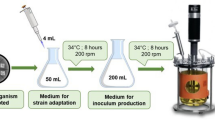Abstract
To improve the nutritional value of pine pollen, a statistical experimental design strategy was applied to optimize the fermentation conditions of pine pollen using Lactobacillus paracasei Lc-3. Influence of the inoculum size, temperature, and initial pH on viable counts and crude protein production was evaluated using a Plaackett-Burman design using the steepest ascent method to approach the experimental design space. Factors were optimized using a Box-Behnken design and response surface methodology. A quadratic model was found to fit the viable counts and crude protein amounts. Optimum values of the tested variables for production of viable counts and crude protein were an inoculum size of 11.92%, temperature=39.60°C, and an initial pH of 7.22. Under optimized conditions, the viable count was 4.24×109 CFU/mL and the crude protein amount was 15.35% (dry matter). A single factor experiment as preliminary research for fermentation product treatment was performed.
Similar content being viewed by others
References
He XY, Sun XY, Yu ZY. Effective components and pharmacological function of pine pollen. J. Northeast For. Univ. 35(9): 78–80 (2007)
Wang LX, Li QW, Chen JY, Yan HM, Li YG. Determination of life elementin Yunnan pine pollen by microwave digestion and ICPAES. Mod. Sci. Instrum. 4: 102–104 (2007)
Khan IA, Abourashed EA. Leung’s Encyclopedia of Common Natural Ingredients. 3rd ed, John Wiley & Sons, Inc., Hoboken, NJ, USA. p. 83 (2009)
Liu X, Hu QZ, Li XN, Bao LX. Study on the anti-fatigue function of pine pollen. Chin. J. Biochem. Pharm. 25: 169–170 (2004)
Wei K, Sun ZH, Tan YL, Wang H, Wang XJ, Zhu RL. Research on the effect of immune enhancement of Taishan pine pollen polysaccharide in murine. Sci. Agric. Sin. 43: 3645–3652 (2010)
Bai SM, Gao AX, Lei LW, Li PR, Li HY, Zheng Z, Yang XM. Protective effects of pine pollen on the gut microecology of rats under chronic stresses. Space Med. Med. Eng. 19: 189–193 (2006)
Cong T, Zhao L, Bao SF. Study on the treatment of rats with benign prostatic hypertrophy by Masson Pine Pollen. Acad. J. PLA Postgrad Med. School. 26: 395–396 (2005)
Ljungh A, Lan JG, Yanagisawa N. Isolation, selection and characteristics of Lactobacillus paracasei subsp. paracasei F19. Microb. Ecol. Health D. 14: 4–6 (2002)
Pagnini C, Saeed R, Bamias G, Arseneau K, Pizarro T, Cominelli F. Probiotics promote gut health through stimulation of epithelial innate immunity. P. Natl. Acad. Sci. USA 107: 454–459 (2010)
Collado MC, Meriluoto J, Salminen S. Role of commercial probiotic strains against human pathogen adhesion to intestinal mucus. Lett. Appl. Microbiol. 45: 454–460 (2007)
Quigley EM. Prebiotics, probiotic, modifying, and mining the microbiota. Pharm. Res. 61: 213–218 (2010)
Tan ZJ, Xiao KY, Xiao QM, Yang SP. Screening of mediums and culture methods for enumerating lactic acid bacteria. J. Hunan Agr. Univ. (Natural Sciences) 27: 398–400 (2001)
Yang ZY, Ma YJ, Chang FQ. Food Inspection. Ver. 2. Chemical Industry Press, Peking, China. pp. 59–61 (2004)
Cui JD, Jia SR. Optimization of medium on exopolysaccharides production in submerged culture of Cordyceps military. Food Sci. Biotechnol. 19: 1567–1571 (2010)
Li X, Ouyang J, Xu Y, Chen M, Song XY, Yong Q, Yu SY. Optimization of culture conditions for production of yeast biomass using bamboo wastewater by response surface methodology. Bioresource Technol. 100: 3613–3617 (2009)
Gheshlaghi R, Scharer JM, Moo-Young M, Douglas PL. Medium optimization for hen egg white lysozyme production by recombinant Aspergillus niger using statistical methods. Biotechnol. Bioeng. 90: 754–760 (2005)
Coulibaly I, Dubois-dauphin R, Danthine S, Majad L, Mejoub T, Destain J, Béra F, Wathelet JP, Thonart P. Preservation of industrial’s lactic acid bacteria (probiotics) by freeze-drying. Biotechnol. Agron. Soc. 15: 287–299 (2011)
Otero MC, Espeche MC, Nader-Macías ME. Optimization of the freeze-drying media and survival throughout storage of freeze-dried Lactobacillus gasseri and Lactobacillus delbrueckii subsp. delbrueckii for veterinarian probiotic applications. Process Biochem. 42: 1406–1411 (2007)
Tsuruta T, Hamidi N. Effect of microwave predehydration on ice crystal formation in freezing process. Nihon Kikai Gakkai Ronbunshu, B Hen/Transactions of the Japan Soc. Mechanical Eng. B 75: 1497–1502 (2009)
Santivarangkna C, Aschenbrenner M, Kulozik U, Foerst P. Role of glassy state on stabilities of freeze-dried probiotics. J. Food Sci. 76: 152–156 (2011)
Carvalho AS, Silva J, Ho P, Teixeira P, Malcata FX, Gibbs P. Relevant factors for the preparation of freeze-dried lactic acid bacteria. Int. Dairy J. 14: 835–847 (2004)
Ching T, Ching K. Freeze-drying pine pollen. Plant Physiol. 39: 705–709 (1964)
Fang GX, Shan LN, Li H, Wu WP, Zhang H. Active lactobacteria counting method in yogurt fermented with multi-stain. J. Biotechnol. 29: 101–104 (2009)
Zhao WZ, Yu ZP, Liu JB, Yu YD, Yin YG, Lin SY, Chen F. Optimized extraction of polysaccharides from corn silk by pulsed electric field and response surface quadratic design. J. Sci. Food Agr. 91: 2201–2209 (2011)
Zhang Y, Li HJ, Dou HT, He ZF, Wu HJ, Sun ZG, Wang H, Huang XG, Ma YQ. Optimization of nobiletin extraction assisted by microwave from orange byproduct using response surface methodology. Food Sci. Biotechnol. 22 (Suppl.): 153–159 (2013)
Zhang G, He L, Hu M. Optimized ultrasonic-assisted extraction of flavonoids from Prunella vulgaris L. and evaluation of antioxidant activities in vitro. Innov. Food Sci. Emerg. 12: 18–25 (2011)
Author information
Authors and Affiliations
Corresponding author
Rights and permissions
About this article
Cite this article
Yang, S., Li, H. Optimization of pine pollen fermentation conditions using Lactobacillus paracasei . Food Sci Biotechnol 24, 155–160 (2015). https://doi.org/10.1007/s10068-015-0021-3
Received:
Revised:
Accepted:
Published:
Issue Date:
DOI: https://doi.org/10.1007/s10068-015-0021-3




